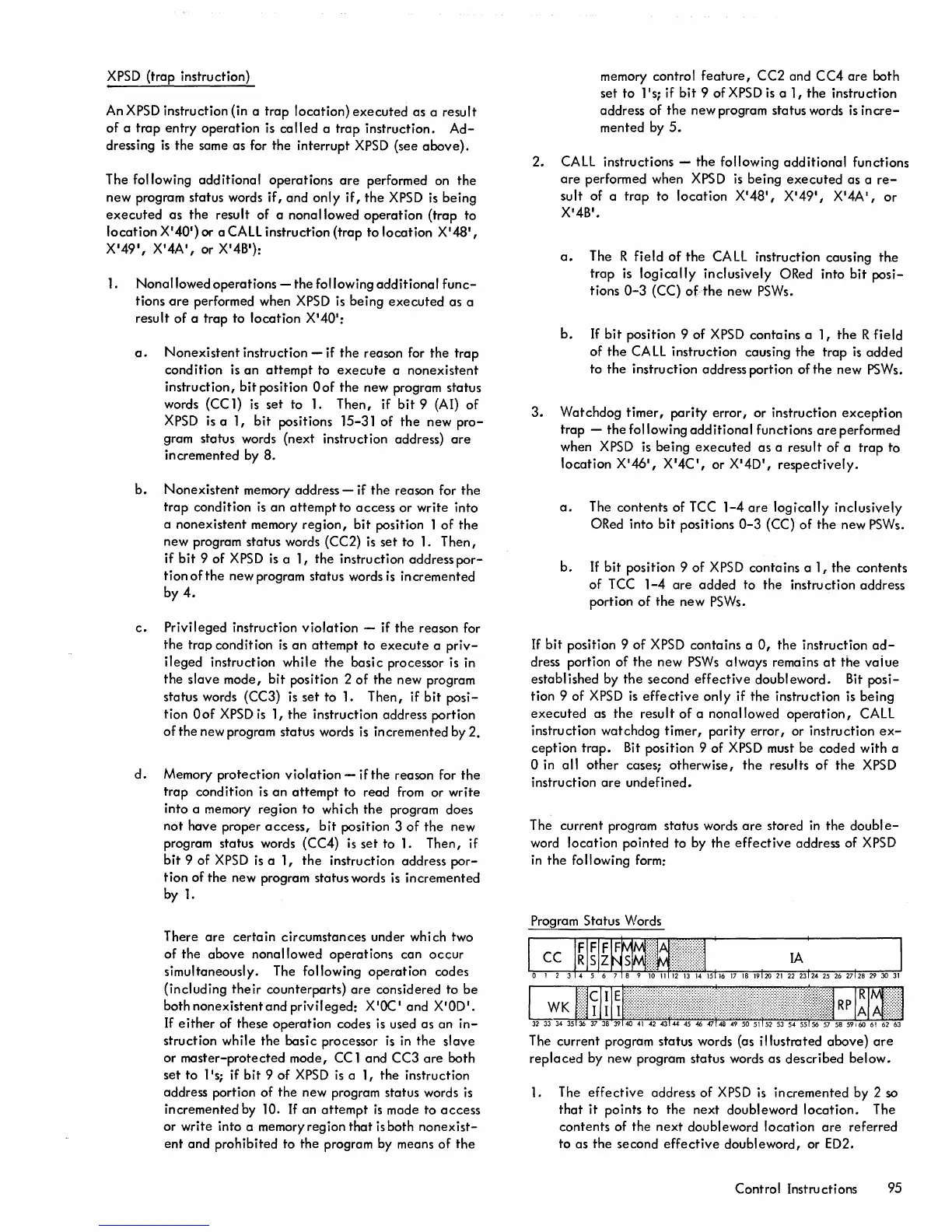XPSD
(trap instruction)
An
XPSD
instruction (in a trap location)
executed
as a result
of
a
trap
entry
operation
is
called
a
trap
instruction.
Ad-
dressing
is
the same
as
for the interrupt
XPSD
(see
above).
The following
additional
operations
are
performed on
the
new program status words
if,
and
only
if,
the
XPSD
is
being
executed
as
the
result of a nonallowed
operation
(trap to
location
X
'
40
'
)
or a
CAll
instruction (trap
to
location
X
'
48
I
,
X
'
49',
X
'
4A',
or X'4B'):
1.
Nonallowed
operations
-
the
following
additional
func-
tions
are
performed when
XPSD
is
being
executed
as a
result
of
a
trap
to
location
X
'
40':
a.
Nonexistent
instruction - if
the
reason for the
trap
condition
is
an
attempt
to
execute
a
nonexistent
instruction,
bit
position Oof
the
new program status
words
(CC
1)
is
set
to 1. Then,
if
bit
9 (AI)
of
XPSD
is
a 1,
bit
positions 15-31
of
the
new
pro-
gram status words (next instruction address)
are
incremented by
8.
b.
Nonexistent
memory address - if
the
reason for
the
trap
condition
is
an
attempt
to
access
or
write into
a nonexistent memory
region,
bit
position 1
of
the
new program status words (CC2)
is
set
to
1.
Then,
if
bit
9
of
XPSD
is
a
1,
the
instruction address
por-
tion
ofthe
new program status words
is
incremented
by
4.
c.
Privileged instruction
violation
- if
the
reason for
the
trap condition
is
an
attempt
to
execute
a
priv-
ileged
instruction while
the
basic
processor is in
the
slave mode,
bit
position 2
of
the new program
status words
(CC3)
is
set
to 1. Then,
if
bit
posi-
tion Oof
XPSD
is
1, the instruction address portion
of
the new program status words is incremented by 2.
d.
Memory protection
violation
-
if
the reason for
the
trap
condition
is
an
attempt
to read from or
write
into a memory region
to
which
the
program does
not have proper
access,
bit
position 3
of
the
new
program status words
(CC4)
is
set to 1. Then,
if
bit
9
of
XPSD
is
a 1,
the
instruction address
por-
tion
of
the new program status words
is
incremented
by
1.
There
are
certain
circumstances under which two
of
the
above
nonal lowed operations can
occur
simultaneously. The following
operation
codes
(including
their
counterparts)
are
considered to be
bothnonexistentandprivileged:
XIOC
I
and X'OD'.
If
either
of these
operation
codes
is
used as an
in-
struction while the
basic
processor
is
in
the
slave
or
master-protected
mode,
CC
1
and
CC3
are
both
set
to lis; if
bit
9 of
XPSD
is
a 1, the instruction
address portion of the new program status words
is
incremented by 10.
If
an
attempt
is
made to
access
or write into a memory region
that
is
both
nonexist-
ent
and
prohibited to the program by means
of
the
memory control
feature,
CC2
and
CC4
are
both
set
to lis;
if
bit
9 of
XPSD
is
a 1,
the
instruction
address
of
the
new program status words
is
incre-
mented by
5.
2.
CALL
instructions -
the
following
additional
functions
are
performed when
XPSD
is
being
executed
as a
re-
sult of a
trap
to
location
X'48
1
,
X'49
1
,
X
'
4A',
or
X'4B'.
a.
The R
field
of
the
CALL
instruction causing
the
trap
is
logically
inclusively
ORed into
bit
posi-
tions
0-3
(CC)
of
the
new
PSWs.
b.
If
bit
position 9
of
XPSD
contains a 1,
the
R
field
of
the
CALL
instruction causing
the
trap
is
added
to
the
instruction address portion of
the
new
PSWs.
3.
Watchdog
timer,
parity
error,
or instruction
exception
trap
-
the
following
additional
functions
are
performed
when
XPSD
is
being
executed
as
a result of a
trap
to
location
X'46
I
,
X'4C',
or
X'4D',
respectively.
a.
The
contents
of TCC
1-4
are
logically
inclusively
ORed into
bit
positions
0-3
(CC) of
the
new
PSWs.
b.
If
bit
position 9 of
XPSD
contains a
1,
the
contents
of
TCC
1-4
are
added
to the instruction address
portion
of
the new
PSWs.
If
bit
position 9
of
XPSD
contains a
0,
the
instruction
ad-
dress portion
of
the
new
PSWs
always remains
at
the
vaiue
established by
the
second
effective
doubleword.
Bit
posi-
tion 9 of
XPSD
is
effective
only
if the instruction
is
being
executed
as
the
result
of
a nonal lowed
operation,
CALL
instruction watchdog
timer,
parity
error,
or instruction
ex-
ception
trap.
Bit
position 9 of
XPSD
must be coded with a
o in
all
other
cases;
otherwise,
the
results
of
the
XPSD
instruction
are
undefined.
The current program status words
are
stored
in
the doubl
e-
word
location
pointed to by
the
effective
address of
XPSD
in
the
following form:
Program Status Words
The current program status words (as illustrated
above)
are
replaced
by new program status words as described
below.
1. The
effective
address of
XPSD
is
incremented by 2
so
that
it
points to
the
next doubleword
location.
The
contents of the
next
doubleword
location
are
referred
to as
the
second
effective
doubleword, or ED2.
Control Instructions 95

